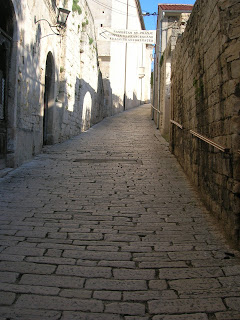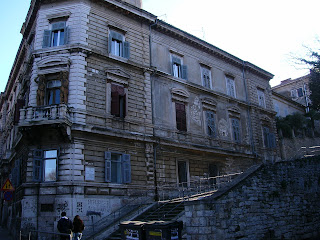 City wall covered in plants.
City wall covered in plants. Looking from one city park to another.
Looking from one city park to another. One of the roads heading to the Center.
One of the roads heading to the Center.The city of Pula is located on the Southern tip of the Istria peninsula in the county of Istria. The area of Pula has been inhabited since the 5th century BC. The Illyrian tribe of the Histri were the first known peoples to find and settle in the area. Roman settlement in the area began in the 1st Century AD. After the Western Roman Empire fell the city was ruled by Ostrogoths, Franks, and the Venetians. Slavs first arrived in the 7th century. Pula and Istria came under Austrian rule in 1848, therefore becoming apart of the Austro-Hungarian Empire. It then became the site of Austria's main naval base and major ship building center. When the Austro-Hungarian Empire collapsed in 1918 all of Istria became apart of Italy. Italian rule lasted until the end of World War II. Pula was administered by the United Nations until the the region became united with the rest of Croatia within the Socialist Federal Republic of Yugoslavia (SFRY). With the fall of the SFRY Pula became apart of modern day Croatia.
 Map of Pula.
Map of Pula. The bell tower of a local church nearby the Arena.
The bell tower of a local church nearby the Arena. Looking toward the harbour area.
Looking toward the harbour area. Allie and her host sister, Paola.
Allie and her host sister, Paola. A harbour.
A harbour. Looking over the edge at some mussels.
Looking over the edge at some mussels. Mussels clinging to the rocks in the harbour.
Mussels clinging to the rocks in the harbour. The harbour at dusk!
The harbour at dusk! Allie and I eating Toast. Toast in Pula is like a panini, with ham and cheese. I added mayonnaise and lettuce to mine...very good! It was weird to be wearing our winter jackets and walking by palm trees and other tropical-like plants.
Allie and I eating Toast. Toast in Pula is like a panini, with ham and cheese. I added mayonnaise and lettuce to mine...very good! It was weird to be wearing our winter jackets and walking by palm trees and other tropical-like plants. Palm trees!
Palm trees! Gabrielle, Emily, Greg, Kevin and Allie on the bus.
Gabrielle, Emily, Greg, Kevin and Allie on the bus. Birthday cake. Kevin had a birthday coming up so Allies host mom baked him a birthday cake for the occasion.
Birthday cake. Kevin had a birthday coming up so Allies host mom baked him a birthday cake for the occasion. The group! Paola, Me, Emily, Greg, Allie, Kevin and Gabrielle.
The group! Paola, Me, Emily, Greg, Allie, Kevin and Gabrielle. Emily cutting the birthday cake.
Emily cutting the birthday cake.The car was small and there was lots of us so we had to get creative with the seating arrangements.
 Kevin and Paola all crammed in.
Kevin and Paola all crammed in. Me, Gabrielle and Greg all squished in the car.
Me, Gabrielle and Greg all squished in the car.The shores surrounding Pula are all rocks, no sand but the beaches as still so gorgeous. I will have to return in the summer when the weather is warmer to take advantage of the nice waters and beaches.
 The Adriatic Sea.
The Adriatic Sea.
 An old ruin.
An old ruin.
 Side view of the Temple.
Side view of the Temple.
 A narrow stone street leading up the hill.
A narrow stone street leading up the hill.
 A street of stairs in Pula.
A street of stairs in Pula.
 There are lots of stairways, paths and roads that twist between the buildings.
There are lots of stairways, paths and roads that twist between the buildings. 
 Bell tower behind the Cathedral of the Assumption of the Blessed Virgin Mary.
Bell tower behind the Cathedral of the Assumption of the Blessed Virgin Mary.
 Unearthed ruins.
Unearthed ruins.

 Diagram of Pula's Center in a local park.
Diagram of Pula's Center in a local park.
 Perserved part of the old wall just down the street from the Twin Gates.
Perserved part of the old wall just down the street from the Twin Gates.
 More of the old city wall.
More of the old city wall.
 Walkway of trees in the Center.
Walkway of trees in the Center.
 Park benches and part of the old city wall in the Center.
Park benches and part of the old city wall in the Center.
 The top corner of the archway. Building with a statue on the room in the background.
The top corner of the archway. Building with a statue on the room in the background.
 Golden Gate
Golden Gate

 Old building with a large staircase leading up to a park on a small hill.
Old building with a large staircase leading up to a park on a small hill. Same building!
Same building!
 A map of one of the many parks in Pula.
A map of one of the many parks in Pula.
 A little decorational hut in the park.
A little decorational hut in the park.
 View of the shipyard from the park on the hill.
View of the shipyard from the park on the hill.
 In the Park.
In the Park.  The El Pulari Mexican resturant where we had dinner!
The El Pulari Mexican resturant where we had dinner!
 The Adriatic Sea.
The Adriatic Sea. An old ruin.
An old ruin.The Temple of Augustus (left) and the Communal Palace (now city hall) in the Forum.
During Classical and Medieval times the Forum was the main square. It was a religious, administrative, legislative and commercial center. There were twin temples and a central one dedicated to Jupiter, Juno and Minerva. Today only one of the twin temples remains intact, the Temple of Agustus. The only remaining part of the second twin temple was the back wall. In the 13th century the remaining back wall was built into the Communal Palace. Today events are still held in the Forum square.
The Roman Temple of Diana (One of the twin temples) was used as a rudimentary City hall from the 9th Century but as the city grew there was a need to construct a City Hall. At the end of the 13th century, on the site of the Temple of Diana a City Hall (Communal Palace) was built. It was finished in 1296. It was built Gothic style using the material of old Roman temples at the site. (The whole back wall of the temple of Diana was used) The building has undergone several reconstructions since first being built but it still remains the City Hall of Pula.
This temple is dedicated to the goddess Roma and Emperor Augustus. It was built between the year 2BC and AD14. There has been many functions of the Temple throughout the years. Until the pagan ancient era ended it was a Temple, after that is was used as a church, granary and a museum for stone monuments. In 1944 a bomb hit and destroyed the building. From 1945 and 1947 it was reconstructed and now houses a collection of ancient stone and bronze sculptures.
 Side view of the Temple.
Side view of the Temple. A narrow stone street leading up the hill.
A narrow stone street leading up the hill. A street of stairs in Pula.
A street of stairs in Pula. There are lots of stairways, paths and roads that twist between the buildings.
There are lots of stairways, paths and roads that twist between the buildings. 
The side of the Cathedral of the Assumption of the Blessed Virgin Mary.
The Cathedral was built in the 6th century. It was built over the remains of a site where the Christians used to gather and pray in Roman times. During the 10th Century the Cathedral was enlarged. It was destructed by Genoese and Venatian raids but was almost completely rebuilt in the 15th Century. During the 16th Century is received a late Renaissance style façade, which is still scene today.
 Bell tower behind the Cathedral of the Assumption of the Blessed Virgin Mary.
Bell tower behind the Cathedral of the Assumption of the Blessed Virgin Mary.Pula is built in a very historical area. It is difficult to get construction done as they are constantly uncovering ancient ruins.
 Unearthed ruins.
Unearthed ruins.
 Diagram of Pula's Center in a local park.
Diagram of Pula's Center in a local park.The Twin Gates!
In ancient times all of Pula was surrounded by walls. In order to enter the city you could pass through one of the ten gates. At the beginning of the 19th Century the walls were old and seen as unnecessary so they were pulled down. Some parts of the walls were preserved. The Twin Gates, two arches that were once a City enterance, were constructed between the 2nd and 3rd Centuries. Nowadays the Twin gates lead to the Archealogical Museum and Castle.
 Perserved part of the old wall just down the street from the Twin Gates.
Perserved part of the old wall just down the street from the Twin Gates. More of the old city wall.
More of the old city wall. Walkway of trees in the Center.
Walkway of trees in the Center. Park benches and part of the old city wall in the Center.
Park benches and part of the old city wall in the Center.Arch of the Sergii (Golden Gate)
Between the years 29 and 27 BC the Sergii family erected this "Golden Gate" in honor a few family members who where in important positions in Pula at the time. The archway leaned against the city gate Porta Aurea but the gate and surrounding wall were pulled down at the beginning of the 19th Century. The arch is in Corinthian style.
 The top corner of the archway. Building with a statue on the room in the background.
The top corner of the archway. Building with a statue on the room in the background. Golden Gate
Golden Gate
 Old building with a large staircase leading up to a park on a small hill.
Old building with a large staircase leading up to a park on a small hill. Same building!
Same building! A map of one of the many parks in Pula.
A map of one of the many parks in Pula. A little decorational hut in the park.
A little decorational hut in the park. View of the shipyard from the park on the hill.
View of the shipyard from the park on the hill. In the Park.
In the Park.  The El Pulari Mexican resturant where we had dinner!
The El Pulari Mexican resturant where we had dinner!Close to Allies house there is a man who has decorated his yard with these intrequite stone structures that he has made. They are extremly well done!






















No comments:
Post a Comment